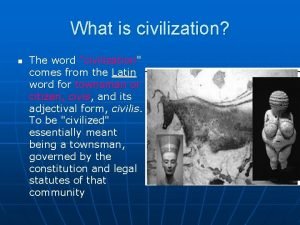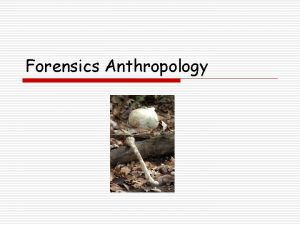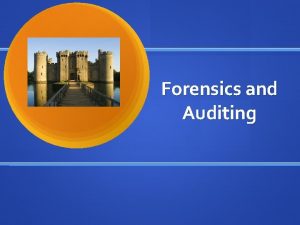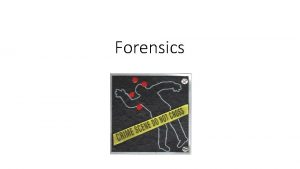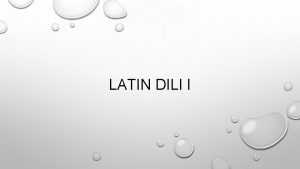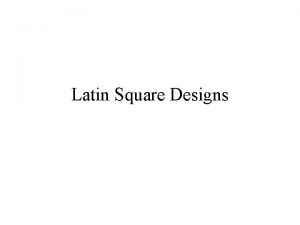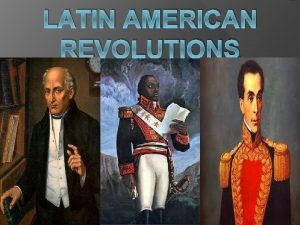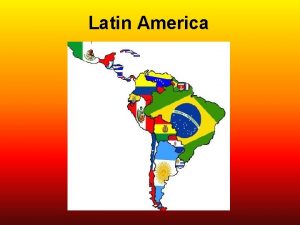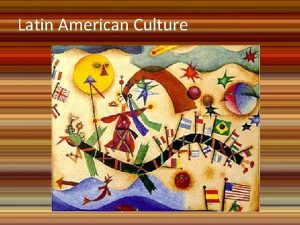HISTORY OF FORENSICS Forensics comes from the Latin













- Slides: 13

HISTORY OF FORENSICS “Forensics” comes from the Latin forensis, meaning a public forum

FAMOUS CRIMINALISTS Vidocq Frenchman Master and former criminal of disguise and escape Applied these abilities and his amazing eye for detail to criminal investigation Created first dept. of investigation in Paris Popular origins of forensics or criminalistics are attributed to the historic Vidocq Sherlock Holmes is based largely on Vidocq Eugène François Vidocq 1775 -1857

FAMOUS CRIMINALISTS Hans Gross Austrian Public prosecutor and judge Published description of applying scientific disciplines to the field of criminal investigation

FAMOUS CRIMINALISTS Edmond Locard Frechman Demonstrated how Gross’ principles could be incorporated into a workable crime lab Founder of Institute of Criminalistics at Univ. of Lyons (renowned center for study and research in forensics) First police crime lab in the world was established in France in 1910 by Edmond Locard Exchange Principle Whenever two objects come into contact with each other, traces of each are exchanged.

HISTORY OF CRIME LABS § First police crime lab in the U. S. opened in 1923 in Los Angeles § The Scientific Crime Detection Lab was founded in Evanston, Illinois in 1929 § The first FBI crime lab opened in 1932 § Opened under J. Edgar Hoover § Most ambitious commitment to forensics

FORENSICS AND THE LAW Bill of Rights Miranda Rights (Miranda Warning) Admissibility Types of Evidence Facets of Evidence of Guilt

BILL OF RIGHTS GIVES INDIVIDUALS THE RIGHT: § To be presumed innocent until proven guilty § Not to be searched unreasonably § Not to be arrested without probable cause § Against unreasonable seizure of personal property § Against self-incrimination § To fair questioning by police § To protection from physical harm throughout the justice process § To an attorney § To trial by jury § To know any charges against oneself

BILL OF RIGHTS GIVES INDIVIDUALS THE RIGHT: § § § § § To cross-examine prosecution witnesses To speak and present witnesses Not to be tried again for the same crime Against cruel and unusual punishment To due process To a speedy trial Against excessive bail Against excessive fines To be treated the same as others, regardless of race, gender, religious preference, country of origin, and other personal attributes

MIRANDA RIGHTS Founded Result on the 5 th amendment right against self-incrimination of 1966 supreme court case Miranda v Arizona Informs you that you have the following rights: 1. You have the right to remain silent 2. Anything you say can and will be used against you in a court of law 3. You have the right to an attorney 4. If you cannot afford an attorney, one will be appointed for you

MIRANDA RIGHTS In 1963, Ernesto Miranda, a 23 year old man, was accused of kidnapping and raping an 18 -year-old woman in Phoenix, Arizona. He was brought in for questioning and confessed to the crime. He was not told that he did not have to speak or that he could have a lawyer present. At trial, Miranda's lawyer tried to get the confession thrown out, but the motion was denied. The case went to the Supreme Court in 1966. The Court ruled that the statements made to the police could not be used as evidence, since Mr. Miranda had not been advised of his rights.

ADMISSIBILITY OF EVIDENCE In order for evidence to be admissible, or usable, it must be: Probative—actually prove something Fingerprint on the murder weapon Material—address an issue that is relevant to the particular crime Frye v United states: Scientific evidence is allowed into the courtroom if it is generally accepted by the relevant scientific community. The “Frye standard” does not offer any guidance on reliability. The evidence is presented in the trial and the jury decides if it can be used. Daubert v. Dow Admissibility determined by: Whether theory or technique can be tested Whether the science has been offered for peer review Whether the rate of error is acceptable Whether the method at issue enjoys widespread acceptance. Whether the opinion is relevant to the issue The judge decides if the evidence can be entered into the trial.

TYPES OF EVIDENCE Class: properties of physical evidence that can be associated only with a group and never with a single source Examples include soil and hair (color and type) Individual characteristics can be identified as having originated with a particular person or source Establishes individuality Examples include fingerprints and DNA

FACETS OF GUILT In order to convict, need to prove: Means—person had the ability to do the crime Motive—person had a reason to do the crime (not necessary to prove in a court of law) Opportunity—person can be placed at the crime
 First comes love then comes marriage
First comes love then comes marriage Revelation in latin
Revelation in latin What does advent mean in latin
What does advent mean in latin It comes from the 2 latin words photos and graphos
It comes from the 2 latin words photos and graphos The word audit has been derived from the latin word *
The word audit has been derived from the latin word * Science comes from the latin word
Science comes from the latin word When was the word computer first used
When was the word computer first used Civilization comes from the latin word
Civilization comes from the latin word What comes to your mind when you hear
What comes to your mind when you hear Why is latin america called latin america
Why is latin america called latin america Hát kết hợp bộ gõ cơ thể
Hát kết hợp bộ gõ cơ thể Bổ thể
Bổ thể Tỉ lệ cơ thể trẻ em
Tỉ lệ cơ thể trẻ em







